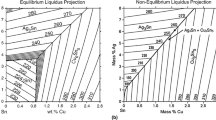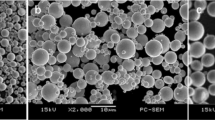Abstract
High aspect ratio (large diameter/thickness) solder joints which are plastically constrained develop large hydrostatic stresses (Friction Hill) greatly in excess of their yield strength. Because the local high triaxial stresses arising from the Friction Hill prevent homogeneous yielding and, in a strain controlled system, will localize plastic deformation within the regions near free surfaces, abrupt brittle fracture through an intermetallic or along an interface can occur. In such situations, the service life of the joint during fatigue situations such as thermal cycling will be greatly reduced. The prevention of triaxial stress build up within such a strain controlled environment which can occur in, for example, leadless chip carrier solder joints requires a distribution of internal free surfaces within the joint. The solder system developed in this study is a thin porous metal film with a regular distribution of pores. The solder material is formed from the usual components, tin and lead. Small lead or tin particles are coated with a thin film of the other component, mixed with flux paste, and the temperature is raised to just above the eutectic temperature. Solid state diffusion occurs across the lead-tin interface until its composition reaches the melting point. The particles then are interconnected by a thin near eutectic liquid film. Additional metal from the solid particle dissolves into the liquid increasing its position and, thus its melting point. Diffusion into the liquid continues until it solidifies isothermally. This forms an interconnecting network of solder “mini-elements” with a dense pore structure.
Similar content being viewed by others
References
D. Frear, D. Grivas and J.W. Morris, Jr.,J. Electron. Mater 17, 171 (1988).
J.K. Lake and R.N. Wild,Proc 28th SAMPLE Symp. (1983), p. 1406.
J. Hagge,Proc. 2nd IEPS (1982), p. 199.
R. Yenawine, M. Wolverton, A. Burkett, B. Waller, B. Russel and D. Spritz,Proc 11th Naval Weapons Electronics Manufacturing Seminar, China Lake, CA (1987), p. 339.
S.B. Stockman and D.W. Coit,Surface Mount Technology: A Reliability Review, Reliability Analysis Center, Griffiss Air Force Base, New York (1986).
A.J. Moniz,Technical Report A JM: 86/2 (Raytheon Submarine Signal Divsion 1985).
J.P. Ranieri, F.S. Lauten and D.H. Avery,J. Electron. Mater. 24, 1419 (1995).
N. Bredz and H. Schwartbart,Welding Rse. Supp. 35, 610s (1956).
N. Bredz,Welding Res. Supp. 33, 545s (1954).
H.P. Meissner and G.H. Baldauf,Trans. ASME, 73, 697 (1951).
W.G. Moffat and J. Wulff,Trans. AIME, 209, 442 (1957).
W.G. Moffatand J. Wulff,WeldingRes. Supp. 42, 115s (1963).
D.H. Avery and W.N. Findley,Quasi-Static Mechanical Testing, Advanced Research Projects Agency; Materials Research Program, August (1968).
G.E. Dieter,Mechanical Metallurgy, (New York: McGraw- Hill Book Company, 1981).
Author information
Authors and Affiliations
Rights and permissions
About this article
Cite this article
Lauten, F.S., Ranieri, J.P. & Avery, D.H. Development of a solder material process to relieve the plastic constraint associated with thin joints. J. Electron. Mater. 24, 1425–1428 (1995). https://doi.org/10.1007/BF02655459
Received:
Revised:
Issue Date:
DOI: https://doi.org/10.1007/BF02655459




